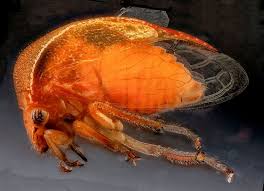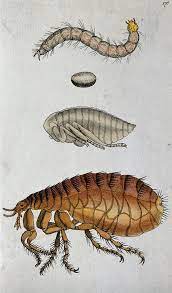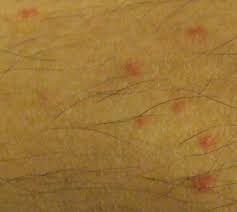The Impact of Fleas: Health Concerns for Pets and Humans
Fleas, those minuscule yet formidable blood-sucking parasites, transcend their outwardly innocuous appearance to become veritable sources of concern. Beyond their capacity to elicit irritation, these creatures wield significant threats that extend their impact far beyond their size, casting shadows over the health and well-being of our beloved pets while also casting a spotlight on potential health risks for humans.
In the realm of pet care, fleas cease to be mere nuisances and instead emerge as formidable adversaries. Their size belies the extent of their potential harm, as they unleash a cascade of health issues that ripple through our furry companions’ lives. These dangers encompass more than just physical discomfort; they seep into the very fabric of a pet’s health and vitality, causing disruptions that can be severe and long-lasting. Simultaneously, fleas become vectors of concern for human health, reminding us that their reach extends beyond their primary hosts.

As the orchestrators of persistent itching and discomfort, fleas are more than just a fleeting annoyance. Their bites give rise to skin irritations that can escalate to inflammations and even open wounds, creating a precarious entry point for secondary infections. Beyond these surface-level consequences, some pets are destined to grapple with allergic reactions triggered by fleabites, a condition known as flea allergy dermatitis. This affliction ushers in severe itching, hair loss, and compromised skin health. In severe infestations, especially among smaller or younger pets, fleas’ voracious appetite for blood can result in anemia, sapping the energy and vitality from these companions. As if that were not enough, these unassuming parasites serve as conduits for various diseases, ensuring that their impact is as multifaceted as it is insidious.
Yet, the sphere of influence for fleas does not stop at pets. These parasites dabble in the human domain as well, albeit with a slightly different modus operandi. While they are not inherently well suited to feeding on humans, they have managed to carve a niche that encompasses more than just irritation. Flea bites on humans, though typically not as concerning as their effects on pets, can lead to itching, redness, and discomfort. For some, these bites can escalate to allergic reactions, adding intensity to the symptoms. Moreover, the scratching induced by these bites can lay the groundwork for secondary infections, accentuating the potential for health complications.

Furthermore, the transmission of certain diseases through fleas adds an element of unease. Murine typhus, a bacterial infection that can cause fever, headache, and body aches, serves as a chilling reminder that these parasites can facilitate the movement of health risks between species. Humans can inadvertently transport fleas into their living spaces if their pets are infested, allowing these creatures to encroach upon human environments and augment the potential for bites and their accompanying risks.
In essence, the world of fleas expands beyond their small stature, revealing their true impact on the health of pets and humans alike. Their capacity to deliver discomfort, disease, and disruption underscores the importance of effective prevention and control measures. Recognizing that their reach transcends seasons and species, it becomes paramount to approach fleas with vigilance and proactive measures, safeguarding both our cherished pets and the intricate interplay between human and animal health.
Fleas unleash havoc upon the health of pets through a multitude of avenues, encompassing a range of dangers that include:
Skin Irritation: Fleabites have the potential to inflict more than just minor discomfort on pets. These bites can trigger a relentless itchiness that drives pets to scratch incessantly, causing their skin to become inflamed and irritated. The continuous scratching can even lead to the development of open sores, creating vulnerable entry points for opportunistic bacteria. These secondary bacterial infections can compound the initial problem, intensifying the pet’s discomfort and posing additional health challenges that demand attention. It is not merely the initial bite, but the subsequent consequences that underscore the seriousness of flea infestations and the urgency to address them promptly.

Allergic Reactions: The consequences of fleabites can extend beyond immediate discomfort, especially in pets with heightened sensitivity. Flea allergy dermatitis (FAD), an allergic reaction triggered by these blood-sucking parasites, can cast a shadow over a pet’s overall well-being. This condition manifests as more than just intense itching; it can lead to profound consequences such as hair loss and the development of skin infections. The persistent scratching driven by the allergic reaction can break down the skin’s natural barrier, allowing harmful microorganisms to infiltrate and create a conducive environment for infection. As a result, what begins as a seemingly benign fleabite can spiral into a complex health issue with ramifications that impact not only the pet’s physical comfort but also their overall quality of life. Understanding the potential for allergic reactions emphasizes the need for vigilant flea prevention and management, as the consequences can be far-reaching and demanding of appropriate care.
In severeinfestations, particularly prevalent among young or small pets, the voracious appetite of fleas for blood can result in a distressing condition – anemia. The depletion of blood caused by these relentless parasites can have a profound impact on a pet’s overall health. Anemic pets may exhibit a noticeable weakness and lethargy, their energy levels plummeting due to the physiological toll exacted by the blood loss. As a telltale sign of anemia, the gums of affected pets may take on a pallid, almost whitish hue, reflecting the reduction in red blood cells and oxygen-carrying capacity within their bodies. This stark manifestation of anemia serves as a stark reminder of the devastating potential of severe flea infestations, highlighting the critical importance of swift intervention and prevention measures. The sight of a weakened pet with pale gums underscores the urgent need to address the underlying cause – the infestation – to restore their vitality and ensure their well-being. It underscores that the impact of fleas goes beyond superficial discomfort and can deeply affect the physical health and vitality of our beloved animal companions.
Disease Transmission: Fleas are not mere biters; they also serve as vectors for a range of diseases that can be transmitted to our unsuspecting pets. The diseases carried by these tiny parasites encompass a spectrum of health threats, ranging from the insidious to the potentially severe. One of the most notorious associations with fleas is their role in the transmission of tapeworms. These intestinal parasites are transmitted when pets inadvertently ingest fleas during grooming, thereby ingesting the tapeworm larvae that the fleas carry. This intricate life cycle underscores the potential for serious health consequences resulting from the close relationship between fleas and tapeworms.
Bartonella, commonly referred to as “cat-scratch disease,” is another disease that fleas are capable of transmitting. While this disease typically affects humans who have been scratched or bitten by infected cats, fleas act as intermediaries in the transmission process. Infected fleas can transmit Bartonella bacteria to cats through their bites, and subsequently, cats can pass on the infection to humans through scratches or bites. This complex interplay between fleas, cats, and humans underscores the potential for disease transmission and the importance of managing flea infestations not only for the well-being of pets but also for the health of the entire household.
In addition to tapeworms and Bartonella, fleas have been associated with the transmission of bacterial and viral infections. While less common, these instances underscore the multifaceted role that fleas play in carrying and disseminating harmful microorganisms. The diseases they carry can impact pets’ health, lead to discomfort, and even create ripple effects within human households. Understanding the potential for disease transmission further emphasizes the need for comprehensive flea prevention strategies that extend beyond the realm of simple nuisance control. By addressing fleas, we not only protect our pets from immediate discomfort but also safeguard them from the hidden threats that these parasites can carry.
Health Considerations for Humans
While fleas mainly target pets, they can also extend their influence to humans, albeit in less dire ways. Fleas are less adapted to feeding on humans, meaning they are more likely to provoke annoyance rather than profound health problems. Nevertheless, a few health concerns related to the interaction between fleas and humans exist:
Flea Bites: The impact of fleas extends beyond our beloved pets, as these tiny parasites can also take a bite out of human comfort. When fleas target humans for their blood meals, the consequences can range from bothersome to potentially concerning. Fleabites on humans typically manifest as small, itchy red bumps on the skin. The persistent itchiness and discomfort can disrupt daily routines and cause annoyance. The bites themselves are often accompanied by localized redness and inflammation, reflecting the body’s immune response to the flea’s saliva injected during feeding.
For some individuals, the consequences of fleabites can escalate beyond mere discomfort. Flea allergy dermatitis (FAD) is an allergic reaction triggered by the proteins present in flea saliva. This condition can turn a seemingly innocuous bite into a major source of distress. In cases of FAD, the body’s immune system reacts strongly to the flea’s saliva, leading to intense and prolonged itching. This can result in more pronounced symptoms compared to a typical fleabite. Affected individuals may experience extensive redness, swelling, and even the development of blisters at the bite site. The persistent discomfort can significantly influence their quality of life, causing them to scratch relentlessly in an attempt to relieve the itching.
The varying intensity of reactions to fleabites highlights the complex interplay between individual immune responses and the components present in flea saliva. While most people may experience mild itching and irritation, those with heightened sensitivity can face a much greater challenge. Understanding the potential for allergic reactions emphasizes the importance of addressing flea infestations not only for the comfort of our pets but also for the well-being of everyone sharing the same living space. By tackling flea populations and reducing the risk of bites, we create a more harmonious environment for both our furry companions and ourselves.
Secondary Infections: The consequences of flea bites can extend beyond the initial discomfort, as excessive scratching of the affected areas can lead to a cascade of complications. The incessant itching prompted by fleabites can drive individuals, both pets and humans, to scratch vigorously in an attempt to alleviate the discomfort. However, this scratching can inadvertently compromise the integrity of the skin, creating small openings or breaks in the skin’s barrier.
These openings provide an entry point for bacteria that are normally present on the skin’s surface. When introduced into the deeper layers of the skin, these bacteria can lead to infections. The result is a secondary bacterial infection superimposed on the initial irritation caused by the flea bite. This secondary infection can intensify the discomfort, causing the affected area to become red, swollen, and potentially painful.

The risk of secondary infections serves as a reminder of the importance of addressing flea infestations promptly. By preventing fleas from biting and reducing the need for scratching, we can minimize the risk of skin damage and subsequent bacterial infections. This proactive approach not only ensures the well-being of our pets but also contributes to a healthier living environment for both them and the humans sharing their space.
Disease Transmission: While the primary victims of flea-borne diseases are often our pets, there exists a lesser-known concern regarding the potential transmission of certain diseases from fleas to humans. Although these instances are relatively infrequent, the consequences can be notable, emphasizing the importance of understanding the risks associated with these tiny pests.
One example of disease transmission via fleas is Murine typhus, a bacterial infection that underscores the intricate relationships between fleas, their animal hosts, and the potential impact on humans. Murine typhus is caused by the bacterium Rickettsia typhi, which is carried by fleas, particularly those that inhabit rodents such as rats and mice. When infected fleas feed on these rodent hosts, they ingest the bacteria. Subsequently, when the infected fleas bite humans, they can transmit the bacteria into the bloodstream, potentially leading to infection.
In humans, the symptoms of Murine typhus can include fever, headache, body aches, and a rash. These symptoms are not only distressing but also mirror those of other common illnesses, making diagnosis and treatment a challenging endeavor. While severe cases are rare and fatalities even rarer, Murine typhus can lead to significant discomfort and compromise the affected individual’s quality of life.
Preventing flea-borne diseases like Murine typhus involves a multifaceted approach that addresses both the health of our pets and the living environment. By implementing effective flea control measures for our pets, we minimize their exposure to infected fleas. Additionally, maintaining clean living spaces and addressing potential rodent infestations can reduce the prevalence of infected flea populations.
The occurrence of diseases like Murine typhus underscores the interconnectedness of the ecosystems we share with our pets and the potential impacts on human health. While the risk of flea-borne diseases to humans remains relatively low, understanding the potential consequences empowers us to take proactive measures that safeguard the health and well-being of both our beloved pets and ourselves.
Pet-to-Human Transmission: The interconnectedness of human and pet environments means that humans can inadvertently carry fleas into their living spaces from infested pets. This can contribute to heightened flea populations in the environment, posing an elevated risk of fleabites for humans.
In essence, fleas might be tiny, but they pack a punch when it comes to the potential threats they pose to both pets and humans. Ensuring effective flea prevention and control measures for pets not only safeguards their well-being but also contributes to minimizing the potential health concerns that fleas can bring to the human population. In conclusion, fleas are not only a nuisance but also a legitimate threat to the health of our pets. While the health concerns for humans are generally milder compared to those for pets, it is important to address and prevent flea infestations to ensure the well-being of both our furry companions and ourselves. Regular preventive measures, including proper flea control for pets and maintaining a clean living environment, can help minimize the risks associated with fleas for both pets and humans.

In summary, the diminutive size of fleas belies the substantial impact they can have on the well-being of both pets and humans. By prioritizing effective flea prevention and control strategies for our pets, we not only safeguard their health but also contribute to mitigating potential health risks posed by fleas to human populations. In conclusion, fleas transcend being mere nuisances and emerge as genuine threats to our pets’ health. While the health concerns they pose to humans are generally less severe, it remains vital to address and prevent flea infestations to ensure the overall welfare of both our furry companions and ourselves. Consistent preventive measures, including rigorous flea control for pets and maintaining a hygienic living environment, serve as essential components in minimizing the associated risks of fleas for both pets and humans.






